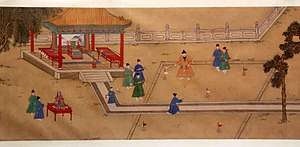Chuiwan
Chuiwan (Chinese: 捶丸; pinyin: Chuíwán; lit.: 'ball-hitting') was a game in ancient China. Its rules resemble modern golf.

The book Dongxuan lu (東軒錄), written by Wei Tai ((魏泰) fl. 1050–1100) of the Song dynasty, describes how a southern Tang official teaches his daughter how to dig goals in the ground and drive a ball into them.[1] The game became popular by the Song dynasty; and a work called Wan jing (丸經 – literally "ball-treatise") of the Yuan dynasty was specially devoted to it.[1] The latest documents about chuiwan in China are from the two paintings of the Ming dynasty from the 15th century.[1] There is a colour image of the mural painting still preserved on the wall of a Water God Temple in Hongdong, Shanxi.[1] A Chinese scholar suggested the game was exported to Europe and then Scotland by Mongolian travellers in the late Middle Ages.
The rules for Chuiwan are remarkably similar to that of modern golf, in that players use restricted number of clubs (up to 10 in Chuiwan, 14 in golf), holes are spread on terrains of varying difficulty, and marked by colored flags; and there is also strict etiquette and rules with regard to player honesty, with penalties for cheating. Chuiwan balls are of different sizes and made of wood. The tee-off areas are called ji, which means "base" in Chinese.[2]
Popularity of this game of Chuiwan peaked in Song dynasty, when Emperor Huizong was reported a dedicated player, it remained a favorite sport during Yuan dynasty and Ming dynasty, in Qing dynasty game of Chuiwan steadily declined, when it became casual game for women and children.[2]
References
- Ling Hongling (1991). "Verification of the Fact that Golf originated From Chuiwan" (PDF). The Australian Society for Sports History Bulletin (14).
- 崔乐泉 (2008). "Ancient Chuiwan Game". Pictorial Journal of Chinese Culture.